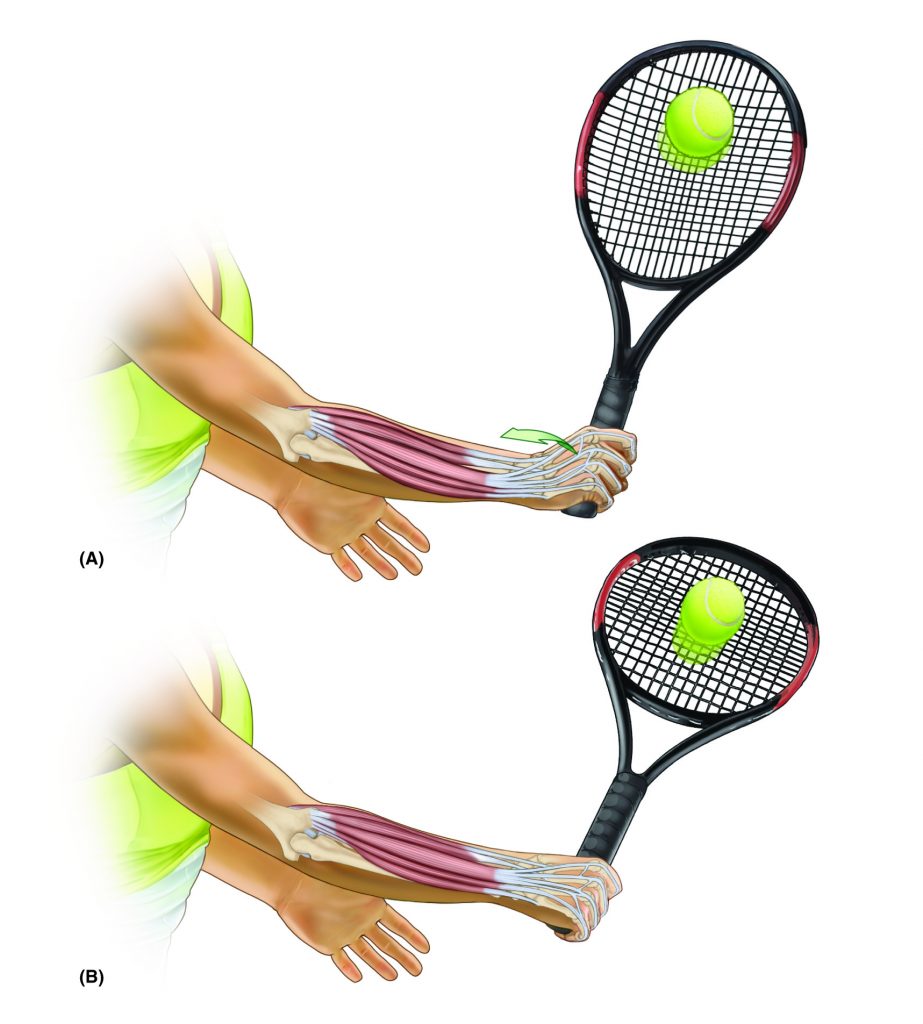Tennis Elbow
 Tennis elbow is one of the most common clinical injuries of the arm related to overuse or sports. Researcher Dimitrios Stasinopoulos prefers the term lateral elbow tendinopathy to describe this condition because other terms such as lateral epicondylitis, lateral epicondylosis, and lateral epicondylalgia, incorrectly assign bone as the principal involved tissue, when in reality it is tendon.
Tennis elbow is one of the most common clinical injuries of the arm related to overuse or sports. Researcher Dimitrios Stasinopoulos prefers the term lateral elbow tendinopathy to describe this condition because other terms such as lateral epicondylitis, lateral epicondylosis, and lateral epicondylalgia, incorrectly assign bone as the principal involved tissue, when in reality it is tendon.
Proposed Exercise Treatments Methods
Various treatments have been proposed with the aim to reduce pain and improve function for clients with lateral elbow tendinopathy. Eccentric contraction loading exercises have been shown to produce good results for tennis elbow. Another proposal is the use of eccentric-concentric loading exercises. And recently, isometric loading exercises have also been proposed for tendinopathy conditions.
Study

Tennis Elbow – Lateral Elbow Tendinopathy – Common Extensor Belly/Tendon
A study published in Journal of Hand Therapy compared the effectiveness of eccentric contraction exercise training, eccentric-concentric contraction exercise training, and eccentric-concentric-isometric contraction exercise training in the treatment of lateral elbow tendinopathy.
A randomized clinical trial was carried out in a rheumatology and rehabilitation center in Athens, Greece. A group of 34 patients with lateral elbow tendinopathy was randomly allocated to:
- Group A: Eccentric exercise of the wrist extensors. The elbow is on the table in full extension, forearm in pronation, wrist joint in an extended position (as high as possible), and hand hanging off the edge of the table. Patients flexed their hand at the wrist joint (toward the floor) slowly while counting to 30 (eccentric contraction phase); then returned (extended) the hand at the wrist joint passively to the starting position with the help of the other hand.
- Group B: Eccentric-Concentric exercise of the wrist extensors. The elbow is on the table in full extension, forearm in pronation, wrist joint in an extended position (as high as possible), and hand hanging off the edge of the table. From this position, patients flexed their hand at the wrist joint (toward the floor) slowly while counting to 30 (eccentric contraction phase as in Group A); then actively extended the hand at the wrist joint, returning the hand to the starting position (concentric contraction phase). (Group B protocol is the same as Group A protocol except that Group B has concentric extension contraction replacing the passive extension of the hand at the wrist joint.)
- Group C: Eccentric-Concentric-Isometric exercise of the wrist extensors. The elbow is on the table in full extension, forearm in pronation, wrist joint in an extended position (as high as possible), and hand hanging off the edge of the table. From this position, patients flexed their hand at the wrist joint (toward the floor) slowly while counting to 30 (eccentric contraction phase); then actively returned to the starting position by concentrically contracting their wrist extensor musculature (concentric contraction phase); then from the starting position, the patient performed an isometric contraction of wrist extensors for 45 seconds (isometric contraction phase). When the isometric contraction was completed, the patient performed further repetitions of this protocol. (Group C protocol is the same as Group B protocol except that Group C adds isometric contraction of the wrist extensor musculature at the end of the protocol.)
All patients received 5 treatments per week for 4 weeks. Pain, function, and pain-free grip strength were all evaluated using a visual analog scale; and function was evaluated using a visual analog scale at the end of the 4-week course of treatment (week 4), and then 4 weeks after the end of treatment (week 8).
Results

Backhand in Tennis – Permission Joseph E. Muscolino – www.learnmuscles.com
The results show that all three treatments reduced pain level, increased function, and increased pain-free strength in people with lateral elbow tendinopathy. However, the eccentric-concentric-isometric contractions (Group C) produced the largest effect in the reduction of pain and improvement of function at week 4 (end of treatment) and week 8 (4 weeks post treatment).
The authors noted two limitations of the study. A small sample size was used and there was no placebo (sham) group.
Conclusion
The authors concluded that, an eccentric training, eccentric-concentric training, and eccentric-concentric-isometric contraction all reduced pain and improved function at the end of the treatment and follow-up for clients with lateral elbow tendinopathy. However, they recommended eccentric-concentric-isometric contraction loading exercise as a first treatment option.
This blog post article was created in collaboration with www.terrarosa.com.au.
(Click here for the blog post article: How do we treat tennis elbow with manual therapy?)

